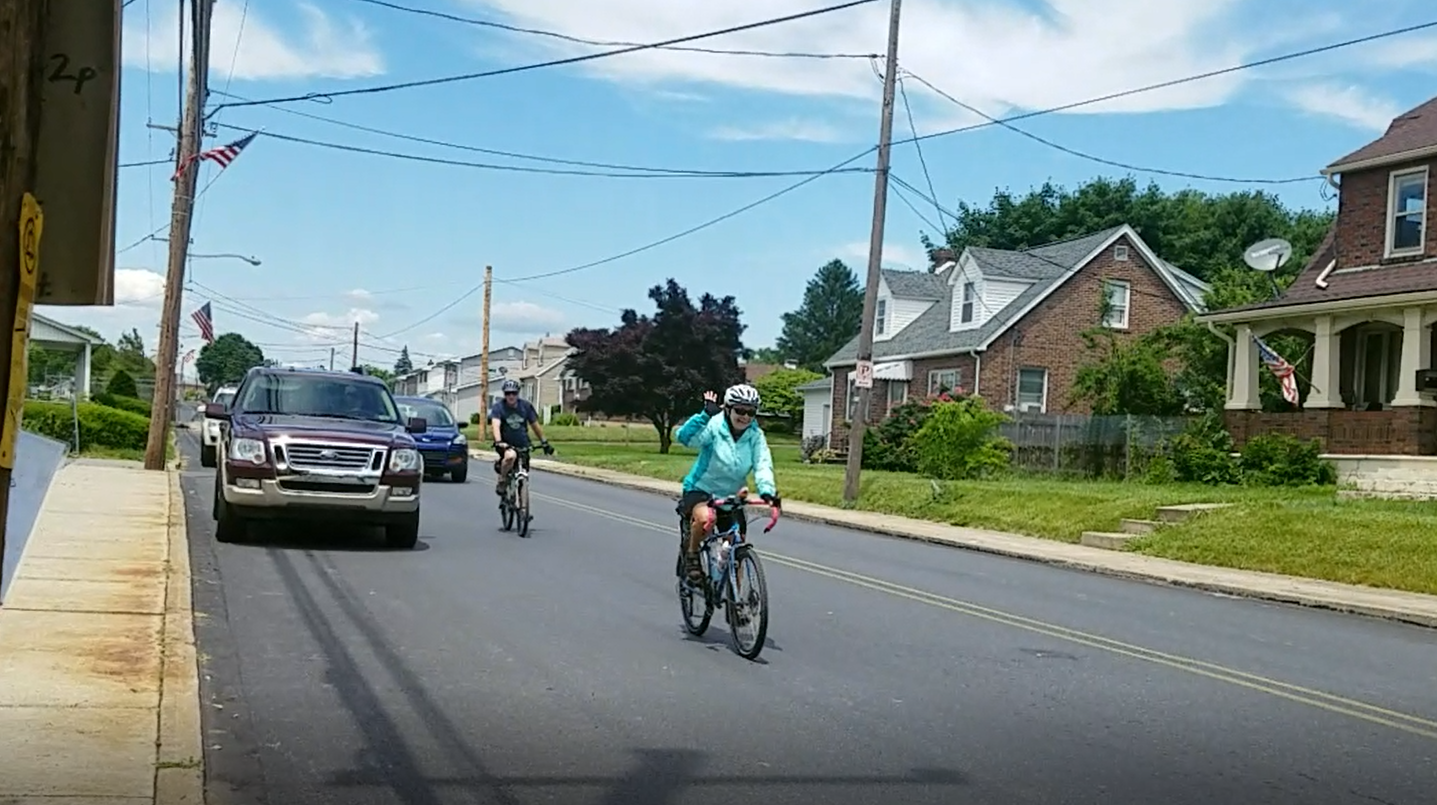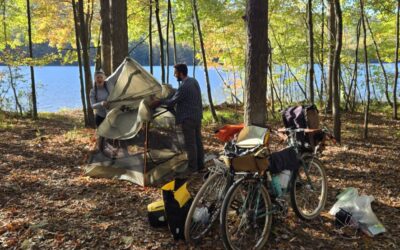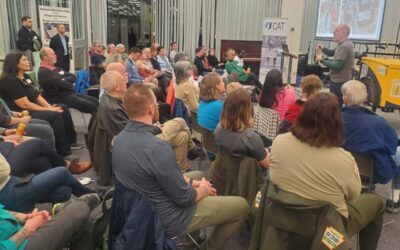On June 11th, about 300 riders traveled the leg of the D & L Canal trail that is not yet fully developed as a trail, as part of the five-day Rail to Trails Conservancy Sojourn traveling from Glen Summit, Pa., near the upper reaches of the Lehigh River, to as far south as Washington’s Crossing on the Delaware River. In other words, these decidedly trail-inclined bicyclists had to ride on the roads for about ten miles, from Northampton to Allentown, Pennsylvania. I enjoyed being one of the volunteers, a number from CAT, helping to direct the riders until they were back on the trail.
From my vantage point at Race and Lehigh Streets in Catasaqua, I saw about a quarter of the riders navigate the intersections without a hitch. They turned right onto Race Street, got in the left turn only lane, signaled their intended left turn, and went with the flow of traffic as they made the turn onto Lehigh Street before heading on south. Many smiled and waved as they went by.
Many more riders negotiated the intersection haltingly. They hugged the right shoulder on Race Street and did not get into the left turn only lane. Instead, they stood by the curb, waiting for the surrounding traffic to clear out (this didn’t often happen, as it was a busy intersection at a busy time of day); or they made the left turn from the right lane, (honking horns, a few shouting drivers) or waited for car drivers to have pity on them and stop until the bicyclists walked across the intersection. They rode as if they were terrified, and the vehicle drivers around them were also in a tizzy, stopping and starting, swerving out of their lane of travel, slowing and speeding up to avoid the cyclists. It wasn’t pretty, it didn’t look very safe, and no one seemed happy. A number of these riders stopped after getting through the intersection, to gather themselves before they carried on.
These were not weak or inexperienced riders. They had the physical stamina to carry on for many miles and anyone could see by the way they handled their bikes that they knew what they were doing. They were adventurers. But they were flummoxed by having to share the road with drivers of motorized vehicles.
Why should these or any trail lovers learn to ride the roads?
Because sometimes it just makes sense. Sometimes you need an emergency detour to a bike shop that is a couple of miles off the road. Or a trail is temporarily off-limits for maintenance. Or the best ice cream or the new brew pub is a few miles off the trail.
If you are a regular trail rider, riding a road should be a breeze, from a purely physical point of view – you will have much less rolling resistance than you‘re used to on the trail. Even if you have to face hills, the workout can only enhance your riding when you get back on the trail. But you will have to learn to ride with ease around drivers of motorized vehicles. It’s not difficult, and it’s probably worth your while to develop road riding skills BEFORE you need them. Fear is not a preferred mindset for learning.
Most especially if you are a dedicated trail rider, consider expanding your riding repertoire and set off to ride some roads. Here are some things to think about:
-
Drivers of Motorized Vehicles Are Not Out To Get You
Sure, there are some aggressive drivers out there, but they are few and far between and probably unlikely to search out the kinds of roads you would choose for cycling. Most drivers are inclined to go along to get along — they’re thinking about their day at work, or what to make for dinner, or last week’s baseball game. They no more want your blood on the hood of their car than you want to be hit by them. Appreciate that when you cycle on the roads in a way that does not threaten the drivers around you, they will do everything in their power to avoid any confrontation with you.
-
Ride Visibly
This is all about road position. Ride where you belong. It’s counterintuitive but true: when you are cycling on the roads, you are safer riding your bike fully on the road, even taking the middle of the lane where it’s too narrow for a car driver to pass you, than you are trying to squeeze off onto a shoulder or the slimmest right-most portion of any travel lane. When you try to stay out of the way of car drivers, they may not see you at all, nor will they slow down for you. Their speed can make them misjudge your road position and endanger you in a number of ways – by cutting you off as they turn in front of you, or clipping you with a side-view mirror,
or not having time to move when you swerve to avoid a pothole or a roadside squirrel.
Also, when you hug the right-most side of the road with parked cars, you occupy the “door zone,” and you risk being badly hurt by a parked car driver opening their door directly in your path.
Do you and the car drivers around you a favor, and take your legally permitted place on the road with confidence. Car drivers are not going to perish if they have to slow down for a mile or two. You are far safer staying out of the shoulder and riding fully IN THE LANE of traffic going your way. When you are making a right turn, stay in the middle of the right lane and signal your intention. When you are making a left turn, look behind you and signal to any oncoming drivers that you want to take up the left position in the lane, then get over to the left and make your turn as oncoming traffic allows.
-
Ride Predictably
Follow the rules of the road. Always ride on the right side of the road, with traffic and never against it. Stop at all stop signs. Follow all traffic signals. When you come to a stop, keep your place in the line of traffic, rather than trying to filter forward. Give pedestrians the right of way at intersections, just as car drivers are required to do.
-
Ride with Confidence
Car drivers can tell if you are an uncertain cyclist, and when they see cyclists all over the road, swerving unpredictably, turning left from a right most lane, their instinct is to GET AWAY. On the other hand, a cyclist who stakes out a clear and straight line of travel, even if doing so means car drivers have to slow down until they can safely pass, gives a car driver confidence that they can safely share the road. When drivers cut you some slack, acknowledge the favor with a cheery wave or a smile.
5. Utilize Your Resources
Pennsylvania is one of many states with designated state bike routes, supported by the Pennsylvania Department of Transportation. These routes criss-cross the state, going east to west and north to south. Detailed cue sheets, elevation data, and much more are available for distinct segments of each route. The routes were developed over a course of years using both professional traffic planners and the experiences of many local cyclists. Go to the PennDOT website (http://www.penndot.gov/TravelInPA/RideaBike/Pages/Pennsylvania-Bicycle-Routes.aspx) for some great ideas on road routes that have been carefully developed and are well-signed. I have not ridden all of the state bike routes, but of those that I have, I have enjoyed the utter beauty of our Commonwealth, taking in the long views of the valleys, on some of the quietest routes you can imagine. Several routes incorporate both roads and trails (i.e., Route S incorporates the Great Allegheny Passage; Route L incorporates some of the D&L.)
Finally, and not least, consider taking a course in riding the roads. Taking a course might seem beneath someone who has already ridden hundreds or thousands of miles on his or her bike. But put your pride aside; if you experience even a bit of hesitation or fear in riding the roads, you will likely benefit from taking a class. CAT offers road riding courses a number of times throughout the year, (for more info, see https://lvcat.org/staging/sign-up-for-a-class/). As an instructor and a regular road rider, I cannot stress how useful these courses are in breaking down people’s fears of riding the roads, no matter how experienced the rider already is. Such classes offer you the chance to test out your skills in a safe environment, to learn techniques in communicating with other road users and to pick up essential road riding skills that will allow you to navigate the roads with as much confidence and pleasure as you ride any trail.
When all is said and done, you might think of roads as trails with a slightly more sophisticated surface. By getting as comfortable on the roads as you are on the trails, you multiply your chances for adventure, many times over. Happy riding.






0 Comments